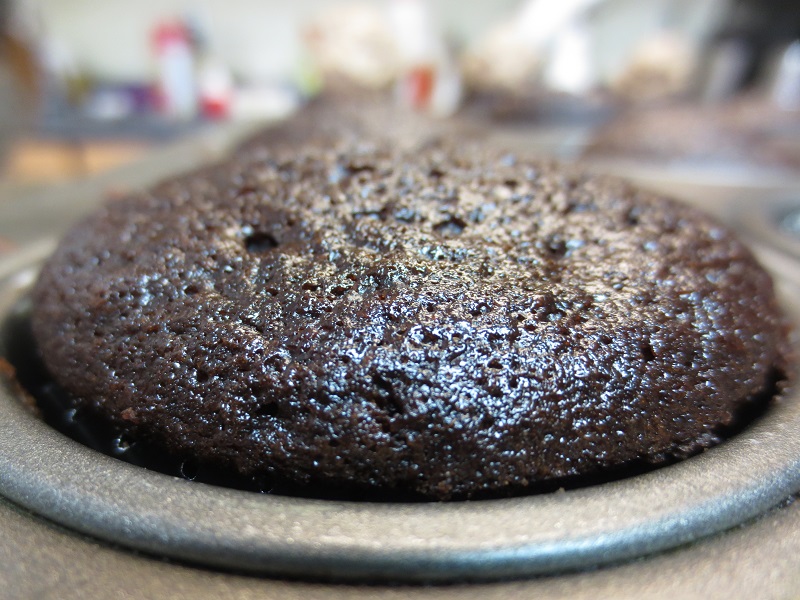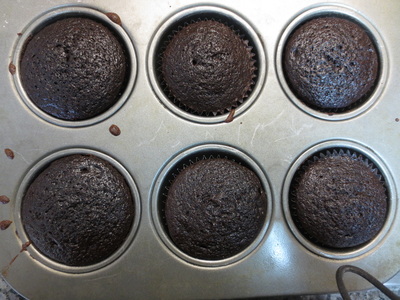
Pretty nice-looking cupcake, isn’t it? Beautifully domed, perfectly sized for the muffin tin cup. And the inside was moist and delicious, in spite of the fact that I overbaked it a bit. (Note to self: Be sure to use the oven timer that measures minutes and seconds, not hours and minutes, when baking something that requires minutes. If I hadn’t realized at about the 20-minute mark that I’d set the wrong timer, the above would be a picture of a lump of chocolate coal. As it was, they probably baked about five minutes more than necessary.) I did frost these with an unbelievably delicious chocolate buttercream, but I’ll be discussing that recipe in a later post.
Below are are two comparison shots of the cupcakes this week and the ones last week.


Last week’s version was a disaster, as you can see on the left. They’ve collapsed in the middle and spread out over the top of the pan, and they were impossible to remove neatly. Their texture was very gooey. (Although one women said that she preferred them over this week’s version!) It was no big deal for this particular occasion, as everyone was very understanding, the cupcakes tasted good, and it was an informal meal. But I wanted to solve the problem and was very puzzled by the results. The recipe was from Martha Stewart, and I had checked and re-checked my ingredients since it was my first time making it. So what had gone wrong? Then it hit me: I hadn’t done any adjustments for high altitude. Normally, for something with a coarse texture and thick batter, such as muffins, it doesn’t matter too much. I usually don’t bother with any changes. But for something light and fluffy, especially with a thinner batter that is dependent on the leavening for most of its structure, the altitude makes a huge difference. I went online and looked up the adjustments given by my old friend King Arthur Flour, and by implementing them I was able to achieve the results that you see on the right. You can see the complete table with all the technical information by following the link, but I followed are listed below. In general, the changes are tied to the lower air pressure at high altitudes, causing baked goods to rise too quickly and then collapse. That is obviously what happened to the first batch of cupcakes. But remember–just to make things confusing, these adjustments are not always necessary. For this recipe they are. I would also say, in general, that for small items such as cupcakes, the high altitude adjustments won’t matter as much as for a big item such as a layer or sheet cake. (Yet another reason to make cupcakes instead of cakes!) But I liked this recipe enough that I was willing to fiddle with it.
Here are the adjustments I used:
|
Recipe Element
|
Change
|
|
Oven temperature
|
Increase 15-25 degrees (Use lower temp. for chocolate items.)
|
|
Bake time
|
Decrease slightly, perhaps 10%
|
|
Sugar
|
Decrease by 1 tablespoon per cup
|
|
Liquid
|
Increase by 3 tablespoons
|
|
Flour
|
Increase by 2 tablespoons
|
|
Leavening
|
MOST IMPORTANT CHANGE;
For altitudes of 5,000 feet (where I live), cut leavening in half. |